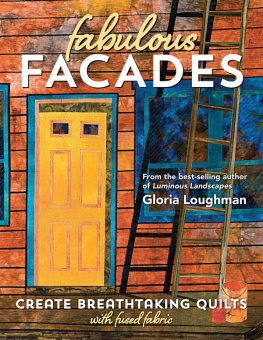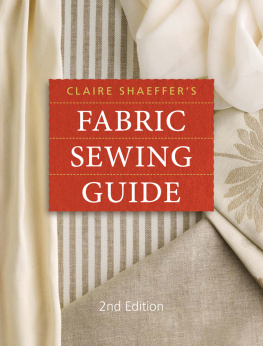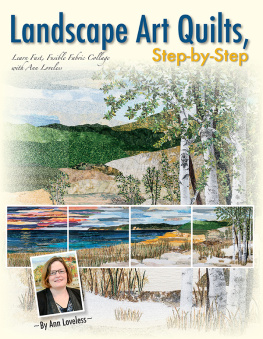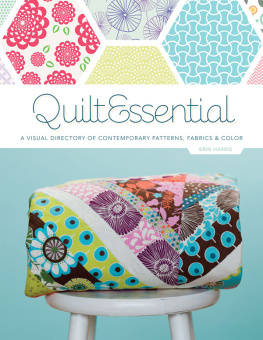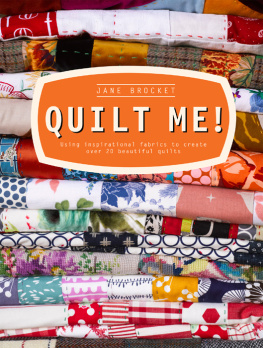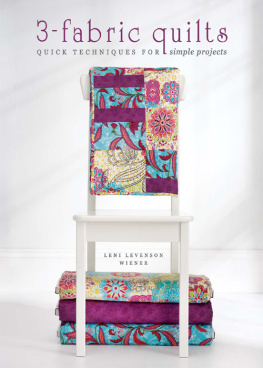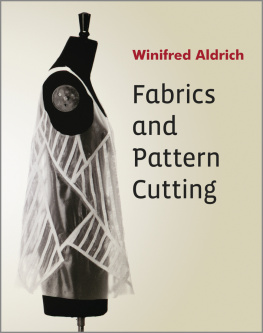Publisher: Amy Marson
Creative Director: Gailen Runge
Editor: Lynn Koolish
Technical Editor: Debbie Rodgers
Cover/Book Designer: April Mostek
Production Coordinator: Tim Manibusan
Production Editor: Alice Mace Nakanishi
Illustrator: Mary E. Flynn
Photo Assistants: Carly Jean Marin and Mai Yong Vang
Photography by Tony Loughman, unless otherwise noted
Published by C&T Publishing, Inc., P.O. Box 1456, Lafayette, CA 94549
Dedication
I dedicate this book to my mother, Florence Jeffery, who sadly passed away while this book was being written. A keen sewer, she resisted quilting for many years as in her own words, she didnt want to become addicted to patchwork like I was. She went on to make hundreds of quilts, most of which were given to great-grandchildren, Ronald McDonald House, and many nursing homes.
I also dedicate this book to our two youngest grandchildren, Matilda and Dashiell. With our grandchildren now totaling nine, they are all a never-ending source of joy and add a wonderful dimension and richness to our busy lives.
Acknowledgments
A big thank-you to C&T for undertaking the publication of this book. My friend and editor for a fourth time, Lynn Koolish, has continued to be a wonderful source of encouragement and wisdom. I really appreciated her skills, support, and patience, as we worked together over the last twelve months. I would also like to acknowledge the work of my technical editor, Debbie Rodgers, whose positive comments and commitment to detail have been invaluable.
To the quiltmakers whose work is showcased in the book, a special thank-you. Your stunning quilts have added further depth and are a unique and exciting feature.
Thank you also to our daughters, Amanda, Sarah, and Rebecca. Your continued love, practical support, and encouragement, especially over this last year, has allowed and indeed inspired me to follow my artistic endeavors.
And finally, thank you to my husband, Tonyincredible photographer, enthusiastic traveling companion, helpful critic and sounding board, computer guru and best friend. What a great journey we have had together! Your advice, positive thinking, incredible support and love has meant so much to me as we have worked on this book together.
INTRODUCTION
When looking at the work of artists, it is interesting to see the progression of themes and techniques as they work along a path that becomes a lifetime journey. There are the easy, downhill sections, where ideas flow and the work is produced quickly and then there is the uphill struggle where nothing seems to work and the progress is really slow. External factors impact on design choices. A holiday to a location full of inspiring scenery, attending an exhibition of another artists work or a captured moment in time, can be the kick-start that sends us off in another direction.
My quilts up to this point have been based on the landscape. Organic shapes, vivid color schemes, and experimenting with abstraction and pattern, have all been features of my work. A number of factors then occurred that had a dramatic impact on the direction of my work. Our eldest daughter returned to university to study architecture. My husband, a keen photographer, printed some superb photos of buildings, and I found within me an appreciation of these structures, which I was very keen to capture in fabric.

Rose Seidler House by Gloria Loughman, 42 54 (107 cm 137 cm)
I have always loved artwork produced using wood-block or linoleum block (also known as lino or linocut) printing techniques. The construction process outlined in this book leads to a design that is reminiscent of a linoleum print. Each main shape is outlined with fine dark lines, which add strength and a more graphic feel to the work.
As part of the construction process, the original building is broken down into key shapes. Each of these shapes or segmentsbe it a wall, doorway, or decorative elementis then constructed on its own base of black or very dark fabric. This way the different sections are easily managed and can be stitched easily and with precision. When all the pieces of the facade and background have been completed, they are appliqud together on the quilt sandwich using fusible web. As each piece of the facade is added in order, you have the feeling you are constructing your own building. Many times, I have watched the delight on students faces as the final shapes are added and their design comes together.
It must be incredible to be an architect and see your design come to fruition. Builders must also gain an immense sense of satisfaction when their buildings are completed. This technique will allow you to create your own facade and I am sure you will feel a similar sense of achievement.
While the word facade is generally used to refer to the front of a building, you can use this construction technique to create other subjects, such as old cars, ships, or any other structure or vehicle, that have a surface area. I have included an example using the outlining technique to construct a container ship (see Cargo Ship Design) and you can make your own old hippie Campervan.
As part of the construction process, the original building is broken down into key shapes. Each of these shapes or segmentsbe it a wall, doorway, or decorative elementis then constructed on its own base of black or very dark fabric.
Always fascinated by pattern, I also took inspiration from tall buildings to make a series of quilts based on skyscrapers. Focusing on the repeated block used for their construction, I filled in the shapes with colored fabrics and stitching. Based on a single block, these quilts have a traditional feel about them but with their dark outlines, they are also quite modern.
As you browse through this book, I am sure your first reaction will be one of pleasure and anticipation as you view many of the wonderful inspirational photographs taken by my husband, Tony. I have been very fortunate to have been invited to teach in some incredibly beautiful places and others, not quite so picturesque, but full of character. I am excited by the patterns and shapes in the big cities and some of their amazing, gravity-defying architecture. I am also unreservedly captivated by old, patched-up houses with clashing color schemes that I am sure have an amazing story to tell. Sometimes, I just cant wait to get home and try to reproduce these treasures in fabric.
After enjoying the visual feast of the inspiring images included, your next thought might be that it is too complicated. A lot of diagrams and instructions. With this thought in mind, I decided to include this image of a quilt made by my granddaughter, Charli, when she was 11. Made as a gift for her parents, it is based on the bathing boxes at a beach near her home. Each box is constructed separately on its own dark base and then stitched to the background. She was able to manage the stitching on the small pieces quite easily and then fused everything down, including the binding! I have also included her most recent quilt, made when she was 12, Eureka Graffiti.

Brighton Bathing Boxes by Charli Bakker, 26 18 (66 cm 47 cm)
I encourage you to have a go at it. It may be your childhood home, the old caravan your parents owned, the incredible skyscraper in your city, or the tumbled-down cottage across the way. All of these are wonderful subjects and deserve to be created in fabric.
I hope you enjoy this book and take up the challenge of making your own facades quilt. My husband and I loved the journey of wandering cities, photographing amazing buildings. Then came my time in the studio, attempting to capture the essence of a facade and its surroundsstill playing with color and pattern, still experimenting with abstraction in backgrounds, always learning and looking forward to starting the next quilt.
Next page
